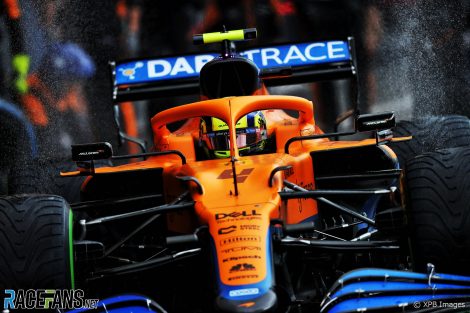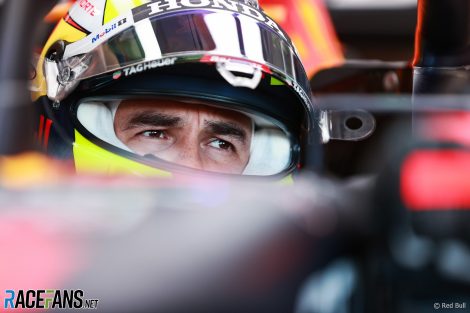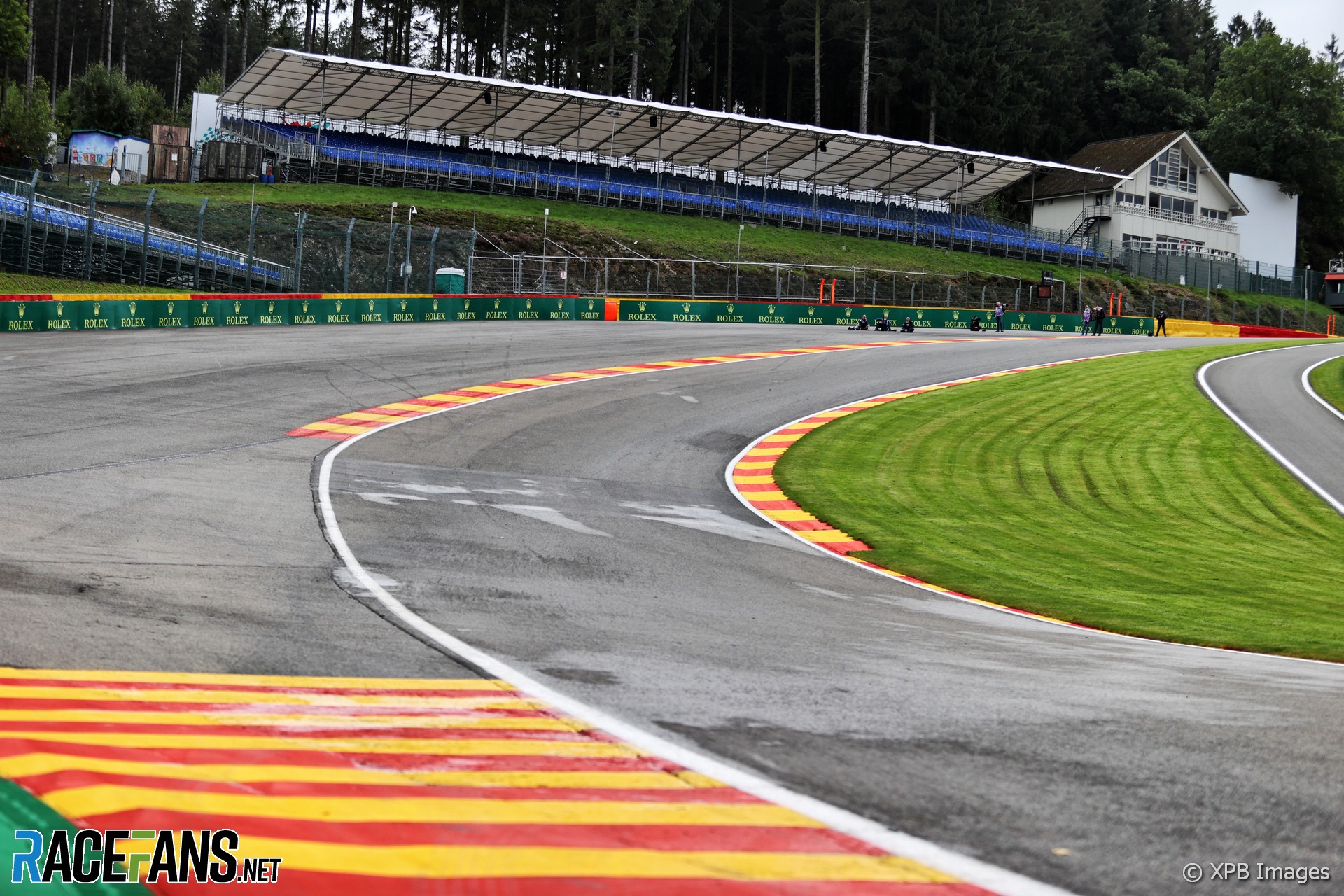The risks posed by the narrow run-off bordering the Eau Rouge and Raidillon sequence were clear before the Belgian Grand Prix weekend began.
But in the two days’ of running prior to this afternoon’s race a series of crashes have made it inescapably obvious why drivers in F1 and other series have raised concerns over it.First there was the shocking six-car pile-up during qualifying for the W Series race. Then Lando Norris smashed his McLaren hard into the Raidillon barrier. Both crashes sent drivers to hospital for checks, though all thankfully avoided serious injury.
In both cases’, the drivers’ responsibility for the crashes was diminished by the fact grip levels were deteriorating due to rainfall. The W Series drivers were caught out when rain fell on a dry track, causing a series of them to spin off in near-identical fashion, piling into each other as some bounced off the Raidillon barrier. Norris, driving an F1 car in conditions which reached the tipping point between ‘very wet’ and ‘too wet’, hit the barrier with far greater force and his wrecked car was thrown violently across the circuit.
The latter scenario is what makes the Raidillon sequence especially dangerous, as shown by the third such crash of the weekend. This occured in the subsequent Formula 3 race when Hunter Yeany and Amaury Cordeel attempted to pass through the sequence side-by-side.
The pair spun, and around a dozen cars behind them were forced to take evasive action. The outcome could have been disastrous, as past crashes have shown. Mercifully, Yeany was missed by his rivals, and although Cordeel was collected, Calan Williams had scrubbed off a lot of speed before hitting him.

Formula 1 drivers were therefore eager to learn of the plans to revise the run-off at the corner ahead of next year’s race. “I was the first driver to ask in the drivers meeting yesterday, seeing what was going to be at the next [race] because I was not aware of any changes yet,” said Alpine’s Esteban Ocon on Saturday.
“We’ve seen too many crashes. We’ve seen obviously Anthoine in 2019 but we’ve seen Jack this year, we’ve seen W Series, I mean, it just keeps going. So we need to do something to make that corner safer.”
Advert | Become a RaceFans supporter and
Ocon said drivers “respect this corner, knowing how dangerous it is”, but the narrow run-off leaves little room for them to avoid being collected if they hit the barrier.
“The run-off at these speeds is too close. And basically the danger is for the car to bounce and go back on the track like it did today, it crossed the track again.”
While the configuration of the corner is expected to remain unchanged, drivers have been shown plans to extend the run-off area at the top of the hill. “Things are going to be taken in place, moving the mountains on the left, going maximum further on the right,” said Ocon.

Sergio Perez echoed Ocon’s thoughts. “We are very concerned about the corner – basically when you hit it, how it sends you back to the track and it’s a blind spot.
“So I really hope to see some solutions for next year. It’s something that we will definitely have to improve because with conditions like today, if we have a wet race tomorrow, it’s not a great place for drivers to have contact.”
However Fernando Alonso, one of the most experienced drivers on the grid, sounded a note of caution, stating it will be impossible to completely eliminate risk from Formula 1.
“We’ve been racing with this configuration for many years,” he said. “We know that it’s a high speed corner and we had some some important accidents, it’s true.
“But I think the FIA is aware of this. We’ve been introducing new devices in the car, new reinforcements in the car. Now they plan to change the barrier on the inside, so there is a continuous working on safety. So that’s very welcome from a driver’s point of view and we all like these efforts.
“But it’s going to be always a motorsport challenge. Zero risk we will never reach, probably. But we are going in the good direction, that’s for sure, so I’m happy.”
Advert | Become a RaceFans supporter and
2021 Belgian Grand Prix
- Spa spectators who saw no racing offered prize draw for 2022 tickets
- Ocon congratulated by past French F1 aces after breakthrough win
- ‘Wrong to award points for a couple of laps behind the Safety Car’ – Horner
- Hamilton offers “exclusive gift” to fans who attended Belgian GP wash-out
- Change rules to give points for qualifying if race can’t happen – Seidl





Jere (@jerejj)
29th August 2021, 9:32
Moving mountains? Good luck with that. As I’ve pointed out before, extending runoff on either side is easier said than done because of limited surrounding space.
René (@)
29th August 2021, 10:04
Have you ever been there?
I think there is enough space to move the barrier. The only “problem” is that white house standing there.
Jere (@jerejj)
29th August 2021, 12:12
@rvg013 No, but Google Maps gives a good view.
John H (@john-h)
29th August 2021, 12:02
Every time a highway is built @jerejj hills and mountains are moved all over the place. It’s what civil engineering is, the only issue is cost. So many crashes lately with cars coming back onto the track, seems like a sensible investment if the money is there.
BasCB (@bascb)
29th August 2021, 12:56
Well said (written) @john-H. I think it will be a very worthwhile investment to avoid having these extremely dangerous accidents time and time again.
Proesterchen (@proesterchen)
29th August 2021, 10:05
“The risks posed by the narrow run-off bordering the Eau Rouge and Raidillon sequence were clear before the Belgian Grand Prix weekend began.”
You state that is if it hurts any less to hit a tyre barrier if you’re aware of its existence prior.
I’d like to take this opportunity to note that the attitude of parts of the Formula 1 media towards safety is simply appalling, as exhibited by the likes of Martin Brundle and David Croft yesterday.
amian
29th August 2021, 10:37
@proesterchen
You’re way more bitter about this than it would be healthy to be. Martin Brundle’s words were very wise in that he urged people not to be too utopian in their expactations of what motorsport could be.
Going 350km/h in a car is dangerous. We can diminish the danger – and we won’t stop doing it, but there’s a ceiling to all of this. That’s all Brundle said.
If a swimmer drowned in competition you wouldn’t ask for the competition to be held out of water, would you?
I think Hubert’s death has made people inadequatly paranoid. Lando’s crash was an ordinary F1 crash, one that typically gets a unanimous “Woah, the cars are so safe! Nice ;)” reaction. But at Spa this year people suddenly go crazy about it wanting to drag the swimmers out of water…
Proesterchen (@proesterchen)
29th August 2021, 12:47
Not making things safer because nothing ever can be safe is not wise. It’s foolish and trite.
If I’m bitter it’s because these two TV personalities apparently think that their viewer base is watching F1 for crashes, injuries, and deaths, and as a long-time viewer of F1, nothing could be further from the truth and I don’t care to be lumped in with that group, if they exist.
bosyber (@bosyber)
29th August 2021, 14:56
Yeah @proesterchen, for me it also really bugged me; I don’t watch F1 for the crashes but for the stellar driving.
John H (@john-h)
29th August 2021, 12:05
Brundle was being balanced in a time when everything has to be so extreme and decisive. He was stating that motorsport is dangerous @proesterchen, which it is. Now they might be able to improve the run off areas, but there will always be some danger to Raidillon. It’s where you draw the line, to be honest I think he got it pretty much spot on. Why race at all, would be much safer?
Proesterchen (@proesterchen)
29th August 2021, 12:43
See, there it is again, this ridiculous excuse for an argument that because nothing ever can be fully safe, we really shouldn’t be doing anything at all. And also “gladitors”. And apparently, these people think their viewers are largely watching to see people get injured and killed, too.
Raidillion is a dangerous corner. People get injured there on a regular basis. Antoine Hubert died.
We know why Raidillion is dangerous. We know how to make it safer, less injury-prone. Let’s not ignore what is right in front of our very eyes.
jlb
29th August 2021, 10:36
Gravel in inner run-off at Radillion, so car gets stuck in there and replace tyre wall with a TechPro.
Euro Brun (@eurobrun)
29th August 2021, 10:44
It feels like how we used to talk about Tamburello corner pre 1994. “Oh there’s nothing we can do, guess we leave it”.
Apart from we’ve already had a death as well as all these subsequent accidents.
I don’t want to lose this corner, but they need to at least try something with the run off. Hopefully the measures already planned will be enough. Even another 20m run off on the left is better than nothing.
bosyber (@bosyber)
29th August 2021, 14:56
Indeed @eurobrun, that’s exactly what it reminds me of.
Armchair Expert (@armchairexpert)
29th August 2021, 10:51
I think it’s a proof that god exists. Because I have no other explanation for a run-off suddenly becoming dangerous 20 (yes, T W E N T Y) years after its inception other than calling it miracle and unexplainable. And no, evolution of cars can’t be a reason, as Schumacher on his pole lap in 2002 clocked 315 kph through Eau Rogue, which is equal to speeds achieved there 20 years later. So, run-off is exactly the same, as is speed cars drive through that section. The only variable that has changed is drivers and their 2021 mentality of leaving no space, banging wheels, cutting corners and feeling immortal, after butchering circuits and cars throughout last 2 decades. They no longer feel fear and this is the result: taking huge risks because they can press reset button like in their favourite video game.
anon
29th August 2021, 11:20
@armchairexpert there have in fact been multiple fatal accidents at Raidillion during that period in other motorsport series, and other drivers who have also been seriously injured in crashes at that location as well (e.g. Pietro Fittipaldi breaking both legs when an electrical failure meant he lost control of the car and crashed during the 2018 Spa 1000km WEC race).
It feels like you’re throwing the blame onto the drivers because it is easy to blame them, even though complaints have been raised in other motorsport series over the years. It is reminiscent of the sort of arguments that were being thrown about in the 1960s by the circuit owners back then – rather than accepting the possibility that there could be an issue with the track, the response was to accuse the drivers of taking too many risks and to blame them instead.
Armchair Expert (@armchairexpert)
29th August 2021, 13:28
@anon 2 fatalities in (pre)historic F3 cars and 1 in bike race – that can happen on any circuit. As for Fittipaldi, again, that’s not circuit’s fault as losing steering control can happen anywhere. Look for “Natacha Gachnang Abu Dhabi 2010” on Youtube. She broke her leg in almost identical crash, but I don’t see anyone claiming Yas Marina with its 200 or so asphalt run-off was to blame there?
Eau Rogue section is identical since 2002 (in 2000 it was 100% gravel, 2001 left side was asphalted, year later they’ve built run-off we see today), cars are doing similar speeds, so what has changed since that it suddenly became “unacceptable”?
Sensord4notbeingafanboi (@peartree)
29th August 2021, 12:02
I know what you mean but a 500kg car losing it at 315, carries less than half the energy of a 800kg car losing it at 315. The run-off was largely the same 20 years but there is a significant omission, gravel. When the run-off spits cars into the path of others you have to fire people.
William KENT
29th August 2021, 12:14
With gravel there you have the risk of cars being launched such as Zonta in 1999. If a car is launched over the tire barrier that Zonta and Villeneuve hit there is a huge cliff on the other side! Not sure which is worse? Cars being launched or being spun back onto the track and t-boned
Armchair Expert (@armchairexpert)
29th August 2021, 13:40
@peartree That’s true, but cars outside F1 aren’t that much heavier than 10 years ago. Dallara GP2/08 was 688 kilos, only 32kgs lighter than 2018 F2 car, while Tatuus used in WSeries weighs 565 kilos. While one can have a case stating it’s very significant factor in severity of impacts in F1 (almost 200 increase, which is simply disgusting), but in other formulas? I don’t think so.
Sensord4notbeingafanboi (@peartree)
3rd September 2021, 0:27
@armchairexpert indeed, on the other hand those cars are slower. That said radillion has claimed many lives during gt races.
amian
29th August 2021, 10:53
“so car gets stuck in there”
Oh, you want the drivers’ inner organs to be smashed to a pulp and their spines broken?
The last thing you want in a crash at 300km/h is to be instantly stopped. The thing you want even less is to get instantly stopped and have another car going at 300km/g t-bone you.
What they need to do is the opposite of what most people suggest – diminish possible angle of hits to the most acute angle by bringing the barriers closest to the asphalt. Something that Aleander Wurz has also suggested. The barriers should be impact absorbing walls like those used at oval tracks in the US.
The walls should be profiled in a way as to provide the safest angle of hit and let the car stick to it and slide forward slowly dispersing energy and slowly decreasing their speed.
This way even if an oncoming car hits the wrecked car it will be at a much smaller relative speed, because the latter won’t be stationery anytime soon.
amian
29th August 2021, 10:55
This is a reply to a jlb’s comment from much above from 10:36
Sensord4notbeingafanboi (@peartree)
29th August 2021, 11:55
10 years overdue. The runoff is the only problem with the corner, cars can’t crash on a corner and end up in the middle of the road. The runoff is tiny, on the left they could easily take it back by 5 to 10 m though that might not be enough.
The runoff on thr right is trickier, interlagos had the same problem and they managed to pull it off. On the left it is easy, they need to clear some forest pull the grandstand and a small building back. Instead of spending 14 million restoring gravel on turns they had no need to take gravel in the first place, spa should have spent their money extending the run off using gravel and tec pro barriers.
Pironi the Provocateur (@pironitheprovocateur)
29th August 2021, 12:14
What crybabies.
Srdjan Mandic (@srga91)
29th August 2021, 12:19
These changes were long overdue. I can’t believe the FIA didn’t pressure the circuit owners into making these changes a lot sooner. Small run-off and tyre barriers at such a dangerous corner may be the worst possible solution, as the cars are likely to rebound off the barriers and back onto the circuit.
Extended run-off (on the left side) and Tecpro barriers all around are a must for next year!
I understand that these changes cost millions of € and you’d try anything to avoid such expensive safety precautions, but surely you can’t put a price on people’s lives.
jlb
29th August 2021, 12:34
> Oh, you want the drivers’ inner organs to be smashed to a pulp and their spines broken?
The last thing you want in a crash at 300km/h is to be instantly stopped. The thing you want even less is to get instantly stopped and have another car going at 300km/g t-bone you.
And that’s why I suggest TechPro barriers. Gravel traps’ job isn’t absorb crash energy.
Scary Terry (@hatebreeder)
29th August 2021, 12:37
What if they set track limits there? stay on the track, no taking the curbs or runoff. they are pushing that hard cause they know they can give that a shot. Invalidate the lap during quali, and impose a penalty during race day will force everyone to stay within the lines.
S
29th August 2021, 12:40
F1 simply needs to ask itself one question in relation to Eau Rouge/Raidillon – and it’s the same question they should be asking themselves at every circuit, every single year:
If this was a brand new proposal for a racing circuit, would it be granted Grade 1 certification?
Is ‘historical significance,’ ‘difficulty’ and ‘financial cost’ sufficient justification for racing at a circuit that would otherwise be considered unsafe?
I’d hope not. Though sadly, I know otherwise.
This section of track/runoff has been giving worse vibes than Imola ’94 for decades…
Balue (@balue)
29th August 2021, 18:37
.and of course no mention how Hamilton was against the change, even though it was yesterday’s headline story.